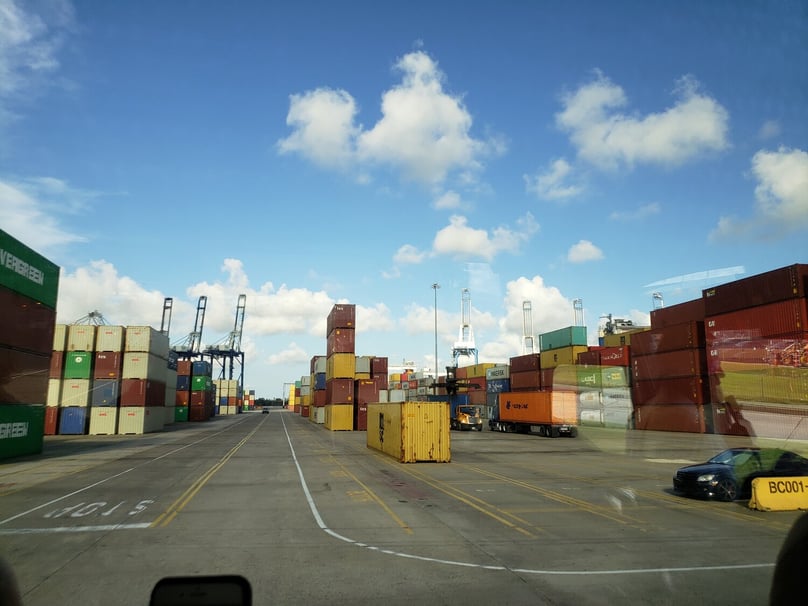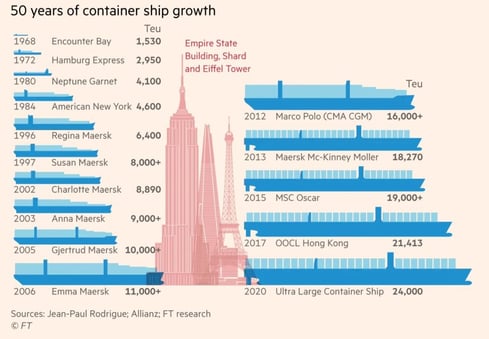What's Up With Container Prices?

If you have priced out a container recently, you know pricing is up. Why is that? Today (March 5th, 2021), we’re going to talk about the different factors that are affecting the market today.
Used to be a Supply Problem
The container market is split into 2 very different segments – the used market and the new market. The major players are shipping lines and leasing lines and container factories. Shipping lines dominate both markets, which drive both supply and demand. Leasing lines order new containers from the factories and then, as their name implies, lease those containers to the shipping lines for anywhere from 7-15 years. When those containers come off lease, they dominate the used container market. Container factories manufacture the containers.
Shipping lines use the containers to ship goods all over the world. Ship sizes have grown over the past few years, requiring more and more containers to fill those ships. To see just how big these ships are, check out this video. Shipping lines have not been keeping up with the amount of containers they need to keep their ships full. Add in that about 10 years ago, there was a large disruption in the market and fewer containers were manufactured and leased out at that time. That dip is now hitting the end of the leasing period, making a dip in the number of containers that will come off lease and available in the used market. Here is a great article that goes into more detail on what happened 10 years ago and how that affects the market today. So before 2020, we were seeing a looming container shortage.
That’s where we were going into the pandemic.
New Containers on the Block
Going into 2020, new container production was moving forward. Since we saw the issues coming down the line on the used side of the market, there was a push to build more one-trip/”new” containers to balance things out, which was a good idea. Then, the pandemic hit.
Here is a video of how containers are made thanks so the great people over at Big Steel Box.
Coming Together for a Perfect Storm
The pandemic made the situation worse. No shocker there.
New production stops every year for a couple of weeks for Chinese New Year. That was at the end of January in 2020. While the workers were home with their families, the pandemic hit and everyone was quarantined. Slowly, workers were then allowed to travel back to work. Production was well below the capacity for months after that and factories have not yet returned to running 24/7.
As the pandemic closed ports throughout the world, container ships were stuck on the water. Ports reopened at lower capacities. Fewer ships were getting unloaded more slowly, which has led to a back-up of ships waiting to be unloaded. Shipping lines canceled sailings. For the ships that did go, these delays continue beyond the port. Containers then move to container yards, rail yards and warehouses where they either continue to inland destinations near and far and are emptied out and the containers go back into circulation for a load leaving that location. All of the Rail delays, delays in trucking, moving of containers to their final destination and the unloading of containers ground the just-in-time shipping system to a halt. Without empty containers to refill, fewer containers were returning to ports to refill ships, leading to more cancellations. This happened and continues to happen on a global scale. You can see videos recently shot by the Coast Guard of the ships waiting to berth at the Port of Long Beach.

Globally, container availability dropped. Prices shot up everywhere, but particularly in China. Containers that would have normally been sold in the US, Europe, Africa and other parts of Asia are all being repositioned to China despite needing them in other markets. As a result, we are left with shortages here in its wake and even higher prices.
There are other fall-outs to this as well. The shortage of containers mean the goods that are ready to be shipped around the world are being slowed down. Anyone who has tried to do a home remodeling project knows current goods and materials are being slowed down. Ditto to anyone in manufacturing are waiting on materials to come in or get out to customers. Even the container market is feeling that with shortages of steel at the container factories.
So When Will It End?
That is the BIG question. No one really knows. New factory orders are backed up to the summer. There are not enough used containers to fill the gap in of what is needed and what is available. It feels like some of the extreme deficiency in containers will slowly be chipped away at. It is unclear how this will ultimately be resolved. In the meantime, we can expect to be in this position at least into the summer, but it is unclear how much longer after that.
In the meantime, we at Super Cubes are trying to keep containers in stock in our most popular cities around the country. Pricing may be higher than what we had this summer, but we do continue to provide containers and modifications to meet your container needs.
EDIT: On the same day that we posted this blog post, The New York Times posted an article discussing the chaos in the shipping industry since the pandemic. It is a great look at what is going on.
EDIT: Added the graphic after blog was written.
Edit 7/16/21 - Here is an updated article talking about how we’re still in the middle of this.
Tags:
Container Pricing TrendsMarch 5, 2021
